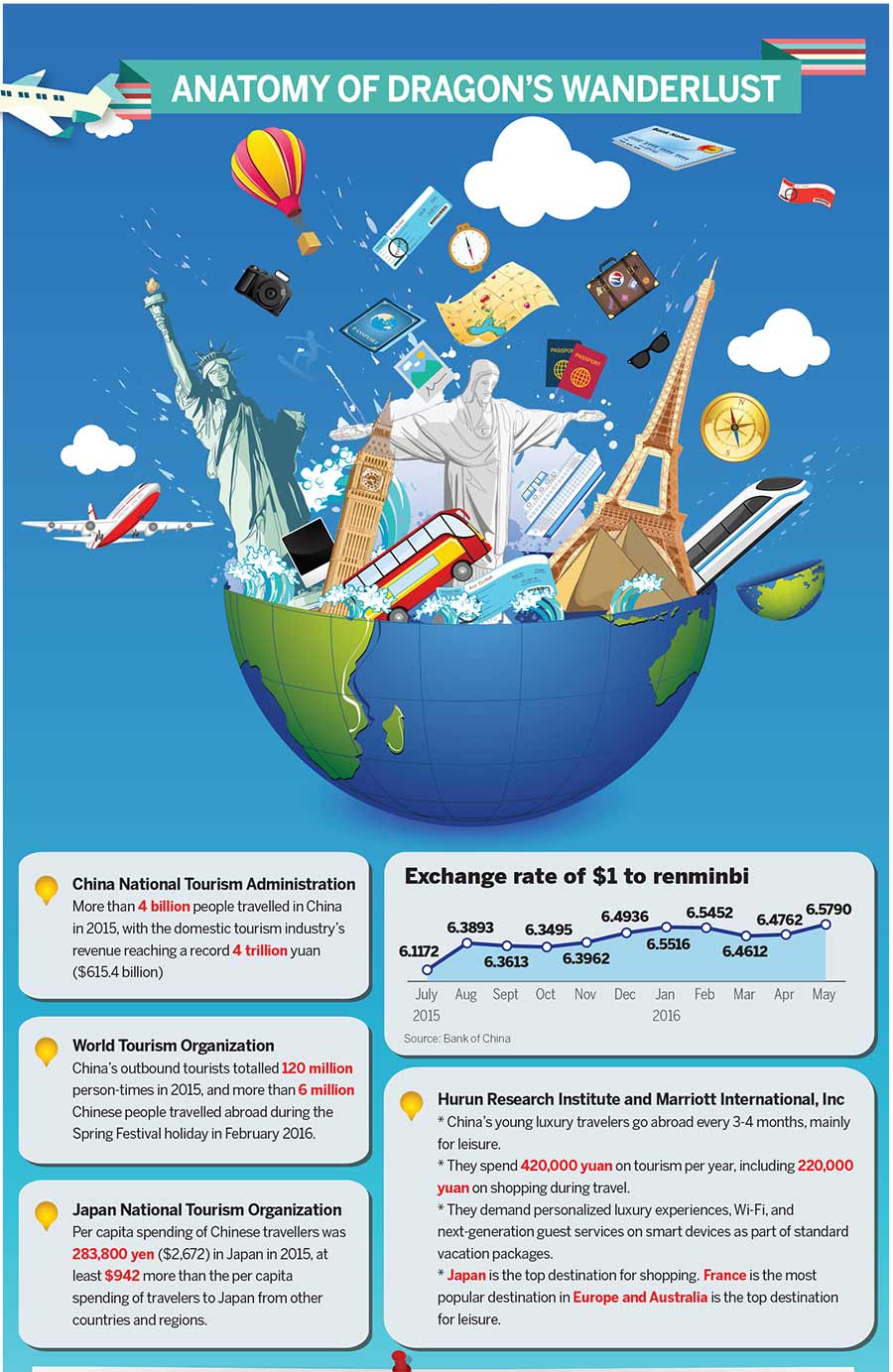
[Su Jingbo and Wang Xiaoying/China Daily]
When the yuan fell to 6.58 to the US dollar, the lowest level in five years, on June 17, it marked the Chinese currency’s 1.4 percent depreciation this year. Alarm bells rang in some sectors, but not in the tourism industry, which continues to remain sanguine.
For, the yuan’s descent against the greenback is unlikely to hurt the market for outbound trips of Chinese tourists, experts said.
Although local currency exchange rates matter in trips to all destinations, not just the United States, it’s the dollar-yuan rate that has implications for other rates.
But, given the yuan’s internationalization, reasonable fluctuations in currency exchange rates are to be expected, and should not cause undue concern, said Jiang Yiyi, director of the International Tourism Development Institute, which operates under the aegis of the China Tourism Academy.
She said the yuan’s current weakness had only a marginal effect on Chinese tourists’ purchasing power abroad. “The impact is minor.”
Agreed executives at top travel agencies.
“The biggest cost in US trips are flights. Prices of most of our travel products were announced six months ago. Recent exchange rate fluctuations have not caused much change in prices,” said the public relations department of Ctrip.com International Ltd, China’s largest online travel agency.

Chinese travelers have fun in Seoul, South Korea and Kyoto, Japan. The two countries are top international destinations for Chinese travelers.[Photo by Liu Debin, Liu Xingzhe and others/China Daily]
On Ctrip, the average price of a trip to the US from China works out to about 20,000 yuan ($3,070) per person.
Like Ctrip, Beijing Utour International Travel Service Co Ltd fixes the yuan prices of its travel products much in advance, sometimes two years beforehand. “The yuan’s recent depreciation won’t get reflected in our prices,” said Li Mengran, its publicity manager. “But (Chinese) tourists’ purchasing power may weaken a bit when they visit US malls.”
A Chinese tourist, she said, may have to fork out 650 yuan this year for a bag that might have sold for 600 yuan last year.
More than half of Utour’s proposed summer trips to the US have been sold already, and are expected to be as popular as those in previous years.
She said boutique tours and in-depth short-term travel products with a focus on children’s interests are well received among Chinese travelers. Summer camps in the US, the United Kingdom and Canada are much sought after. Parents also prefer Singapore and Malaysia as they involve short (six-hour) flights.

Chinese travelers have fun in Seoul, South Korea and Kyoto, Japan. The two countries are top international destinations for Chinese travelers.[Photo by Liu Debin, Liu Xingzhe and others/China Daily]
Two factors are key to outbound Chinese tourists who double up as consumers abroad.
One, the widening price gap between imported goods in China, which are perceived as superior, and the same products bought abroad. So, Chinese travelers tend to buy a lot at duty-free shops during their trips as this works out cheaper than buying imported goods in China, which are subject to high taxes and hence expensive.
Two, Chinese consumers’ low confidence in domestic brands, which experts blame on poor supervision of quality, especially of baby-and-mom goods like infant formula and maternity products, medicines, health supplements, even personal hygiene items.
The travel-and-shop phenomenon is consistent with the broad global trend of the past five years.
Over the next 10 years, the growth in travel spending is broadly expected to outpace the global economy, according to a report of Visa Inc, the cards company.
China tops the chart with a projected growth of 86 percent over a 10-year period, in terms of spending on international travel, which is estimated to rise from $135 billion in 2015 to $225.4 billion in 2025.

Chinese travelers have fun in Seoul, South Korea and Kyoto, Japan. The two countries are top international destinations for Chinese travelers.[Photo by Liu Debin, Liu Xingzhe and others/China Daily]
According to Ctrip’s 2016 Outbound Trips Report, Chinese made more than 120 million outbound trips in 2015, up 12 percent year-on-year.
Chinese aged between 25 and 35 travel overseas the most, accounting for 45 percent of outbound travelers from China. Those aged between 36 and 45 rank next with a 28 percent share.
In terms of Ctrip’s city-wise breakdown, tourists from Shanghai, Beijing, Guangzhou, Shenzhen and Hangzhou travel abroad the most, accounting for half of its overseas travelers.
In terms of individual travelers versus group tours, the former lead with a little over 50 percent share, according to Ctrip.
Top overseas destinations are Hong Kong, Seoul, Phuket, Singapore, Taipei and Tokyo.
The evolution of outbound tourism in China has brought in its wake new demands, particularly from young Chinese travelers.
They demand personalized luxury and digital innovations, according to a report by Marriott International and the Hurun Research Institute released on May 30.
The report’s key findings reveal a shift in travel habits among the younger generation aged 18 to 36.
Besides personalized luxury experience, they seek value throughout the hospitality ecosystem-from planning a trip to guest services to selecting the right kind of loyalty program.
The report said China’s young luxury travelers prefer digital methods to seek services and information. Interactive guest services on smart devices are far more popular than traditional guest services, and travelers also expect this smart technology to record and manage their personal preferences.
Furthermore, they conduct their research on digital platforms. WeChat emerged as their primary source of travel information, obtained from official WeChat accounts and the accounts of friends and professional travel advisers. Third-party apps are also important information channels. Popular platforms include CTrip, Qunar and Tuniu.
According to Research Co Ltd’s 2016 China Online Travel Market Research report, online outbound travel market saw 36.8 billion yuan in sales in 2015.
Online sales now account for 20 percent of all trip bookings in China.
Diverse in their motivations, young Chinese are seeking a wider choice of unique and novel travel experiences. They are interested in adventure travel, polar exploration and road trips that take them further afield to a wider range of destinations around the globe, the report said.
Rupert Hoogewerf, Hurun Report’s chairman and chief researcher, said, “Despite the (Chinese) economy slowing, the impact on outbound travel of high net worth individuals seems to have steadily grown. The young luxury travelers have developed significant spending power, minted on the back of the recent boom in Chinese entrepreneurship, together with a growing class of second-generation ‘rich kids’.”
